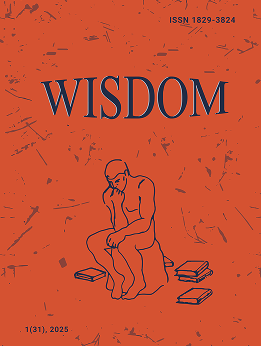Law and Logic: E. Bulygin’s Deductive Pattern of Judicial Reasoning
DOI:
https://doi.org/10.24234/wisdom.v1i1.673Keywords:
legal reasoning, application of law, creation of law, E. Bulygin, logic in law, judicial syllogism, legal realism, subsumption, judicial decisionAbstract
In the twentieth century, the debate over the possibilities and limits of logic in law became particularly acute with the emergence of judicial realism, a philosophical and legal trend that denied the deductive nature of judicial decision-making. This compromised the theory of the judicial syllogism, assuming that a judicial decision could be deduced as a logical consequence from the premises - norms and facts, and generally provoked a sceptical attitude towards logic in law. The subject of the article is the deductive model of the justification of judicial decisions proposed by the outstanding legal philosopher Eugenio Bulygin. The aim of the article is to show Bulygin’s contribution to the improvement of the deductive model of judicial reasoning. The main innovations Bulygin brought to the deductive model of judicial reasoning are: 1) justifying, based on logical analysis and open texture of language theory, the analytical character of the court interpretative sentences; 2) distinguishing the individual and the generic subsumptions, etc. At the same time, the authors conclude that Bulygin’s improved deductive theory is not free from criticism, as the Argentine jurist does not succeed in complete eliminating doubts about the logical deducibility of at least some categories of decisions from general rules.
Downloads
References
AlchourrÛn, C. E., & Bulygin, E. (1971). Normative systems. New York: Springer.
AlchourrÛn, C. E., & Bulygin, E. (2015a). Expressive conception of norms. In E. Bulygin, Essays in legal philosophy (pp. 146-170). Oxford: Oxford University Press.
AlchourrÛn, C. E., & Bulygin, E. (2015b). Limits of logic and legal reasoning. In E. Bulygin, Essays in legal philosophy (pp. 252-271). Oxford: Oxford University Press.
AlchourrÛn, C. E., & Bulygin, E. (2015c). On the concept of a legal order. In E. Bulygin, Essays in legal philosophy (pp. 124-135). Oxford: Oxford University Press.
Alexy, R. (2007). The weight formula. In J. Stelmach, B. Broz?ek, & W. Za?uski (Eds.), Studies in the philosophy of law. Frontiers of the economic analysis of law (pp. 9-27). Krakow: Jagiellonian University Press.
Armgardt, M., Canivez, P., & Chassagnard-Pinet, S. (Eds.) (2015). Past and present interactions in legal reasoning and logic. Dordrecht: Springer.
Berman, H. J. (1983). Law and revolution: The formation of the Western legal tradition. Cambridge: Harvard University Press.
Bulygin, E. (1991). Sentencia judicial y creaciÛn del derecho (Judicial decisions and the creation of law, in Spanish). In C. E. AlchourrÛn & E. Bulygin, An·lisis lÛgico y direcho (Logical analysis and law, in Spanish) (pp. 355-369). Madrid: Centro de Estudios Constitutionales.
Bulygin, E. (1995). Cognition and interpretation of law. In L. Gianformaggio & S. L. Paulson (Eds.), Cognition and interpretation of law (pp. 11-35). Torino: G. Giappichelli editore.
Bulygin, E. (2008). What can one expect from logic in the law? (Not everything, but more than something: A reply to Susan Haack). Ratio Juris, 1(21), 150-156.
Bulygin, E. (2013). Predislovie k russkomu izdaniyu (Preface to Russian edition, in Russian). In E. N. Lisanyuk (Ed.), ìNormativnye sistemyî i drugie raboty po filosofii prava i logike norm (ìNormative systemsî and other works in philosophy of law and logic of norms, in Russian) (pp. 44-46). Saint Petersburg: SPbSU Publ.
Bulygin, E. (2015a). The concept of efficacy. In E. Bulygin, Essays in legal philosophy (pp. 37-51). Oxford: Oxford University Press.
Bulygin, E. (2015b). Judicial decisions and the creation of law. In E. Bulygin, Essays in legal philosophy (pp. 75-87). Oxford: Oxford University Press.
Bulygin, E. (2015c). The objectivity of the law. In E. Bulygin, Essays in legal philosophy (pp. 302-310). Oxford: Oxford University Press.
Bulygin, E. (2016). Logika i pravo (Logic and law, in Russian). In E. V. Bulygin, Izbrannye raboty po teorii i filosofii prava (The selected writings in theory and philosophy of law, in Russian) (pp. 73-79). Saint Petersburg: Alef-Press.
Hart, H. L. A. (2012). The concept of law. (3rd ed.). Oxford: Oxford University Press.
Kelsen, H. (1970). Pure theory of law. Berkeley: California University Press.
Mill, J. S. (1872). A system of logic, ratiocinative and inductive: being a connected view of the principles of evidence and the methods of scientific investigation: in two vol. (Vol. 2, 8th ed.). London: Longmans, Green, Reader and Dyer.
Ross, A. (1944). Imperatives and logic. Philosophy of Science, 1(11), 30-46.
Savigny, F. C. von. (1831). Of the vocation of our age for legislation and jurisprudence. London: Littlewood & Co. Old Bailey.
Savigny, F. C. von. (1847). System des heutigen rˆmischen Rechts (System of the modern Roman law, in German). (B. 6). Berlin: Veit.
Savigny, F. C. von. (1867). System of the modern roman law. (Vol. 1). Madras: J. Higginbotham.
Shershenevich, G. F. (2016). Obshchaya teoriya prava (General theory of law, in Russian). In G. F. Shershenevich, Izbrannoe (Selected works, in Russian) in 6 vols. (Vol. 4, pp. 8-696). Moscow: Statut.
Downloads
Published
How to Cite
Issue
Section
License
Copyright (c) 2021 Author and scientific journal WISDOM

This work is licensed under a Creative Commons Attribution-NonCommercial 4.0 International License.
Creative Commons Attribution-Non-Commercial (CC BY-NC). CC BY-NC allows users to copy and distribute the article, provided this is not done for commercial purposes. The users may adapt – remix, transform, and build upon the material giving appropriate credit, and providing a link to the license. The full details of the license are available at https://creativecommons.org/licenses/by-nc/4.0/.















